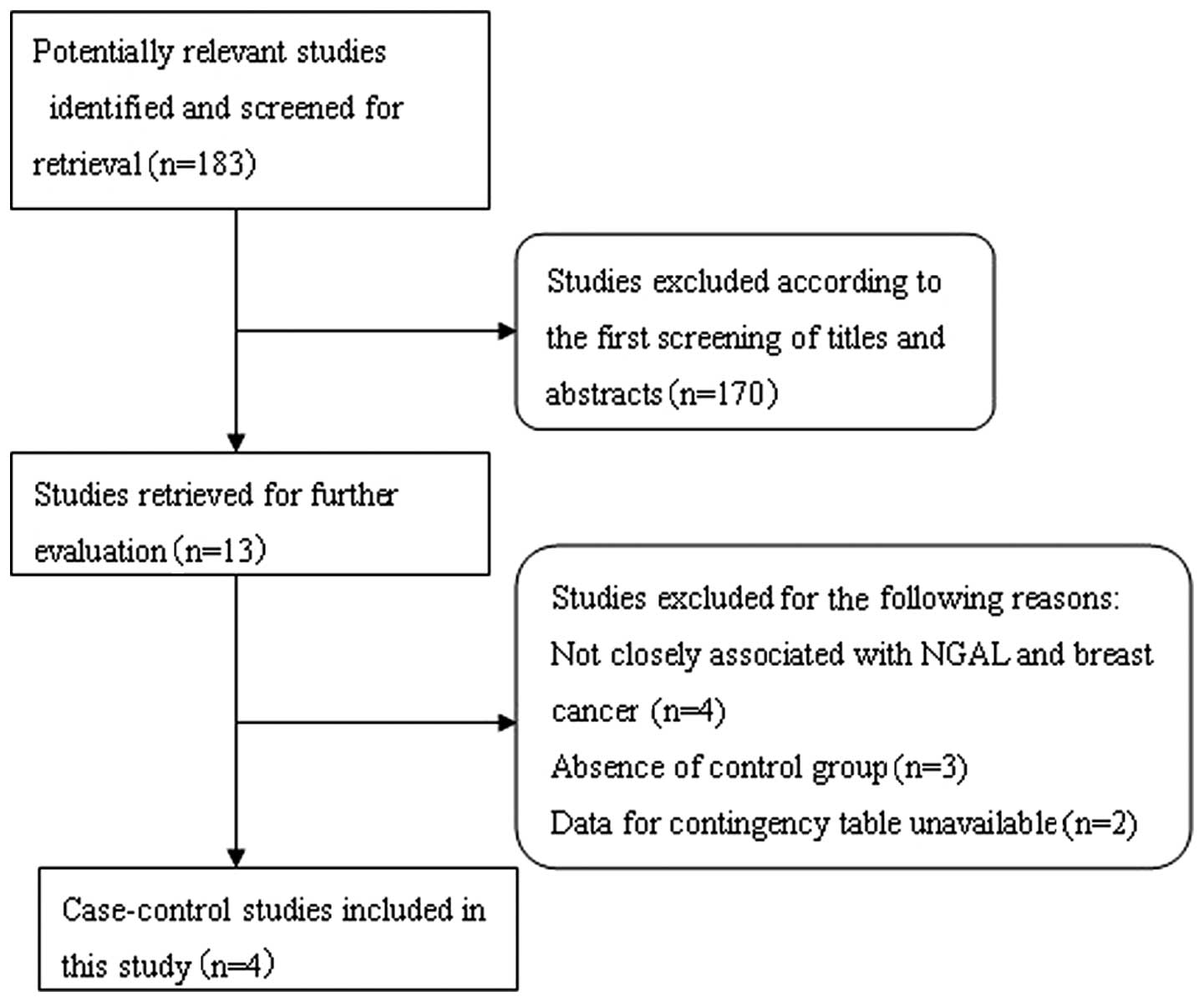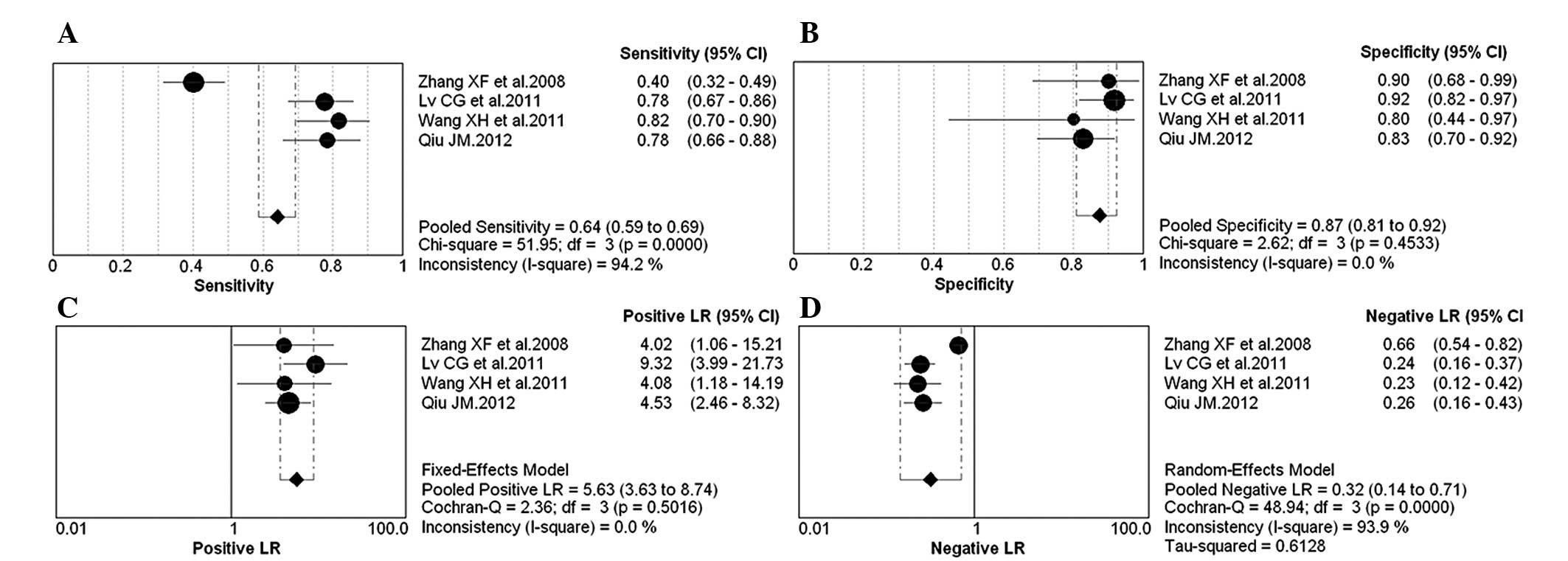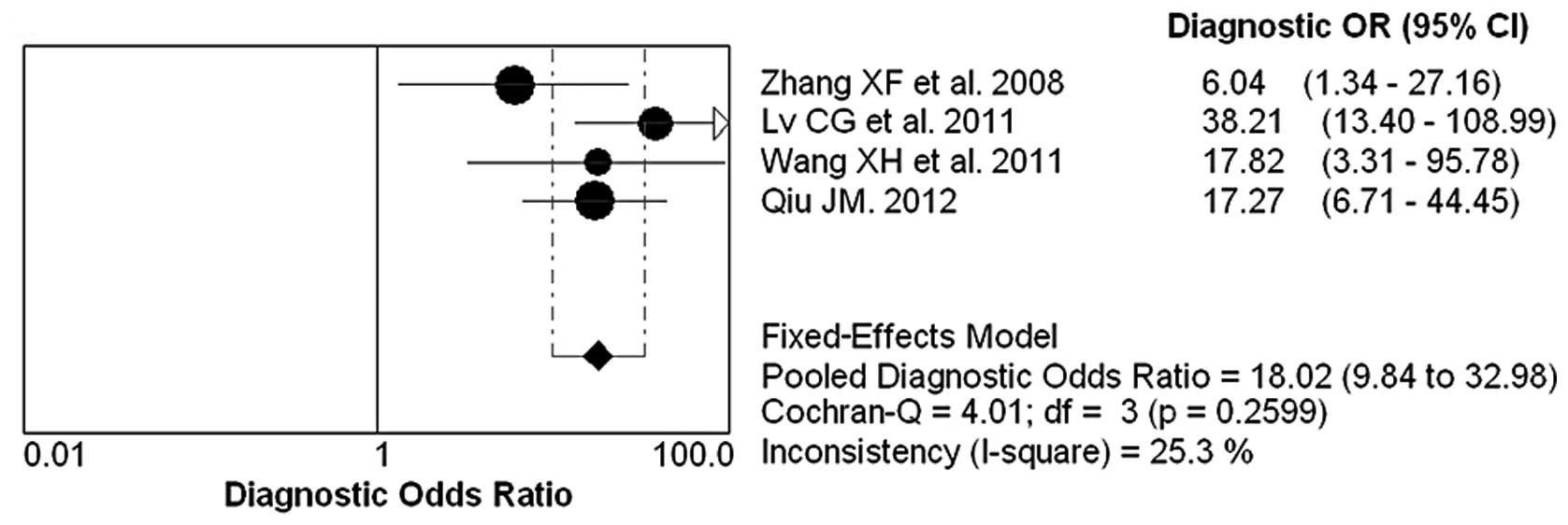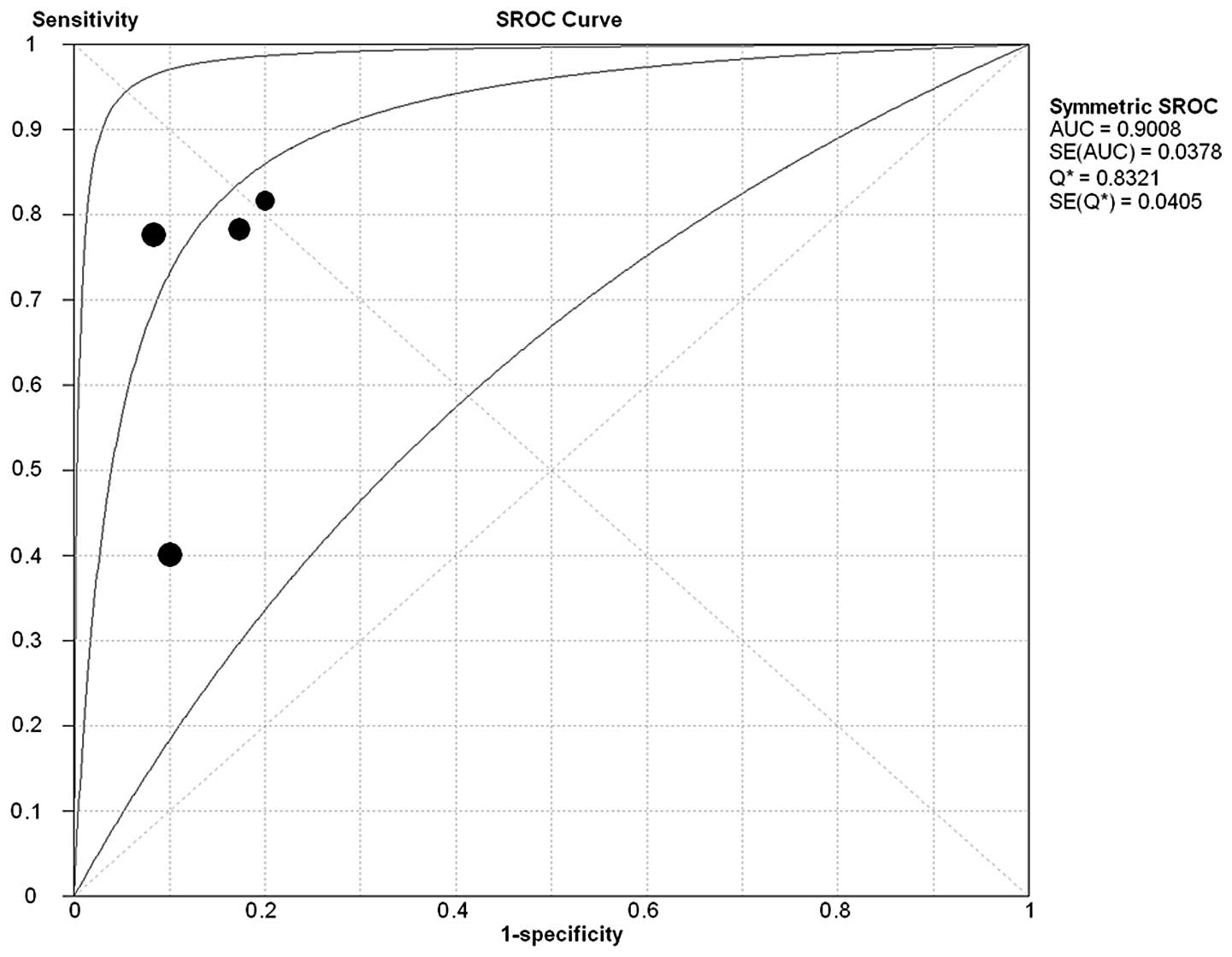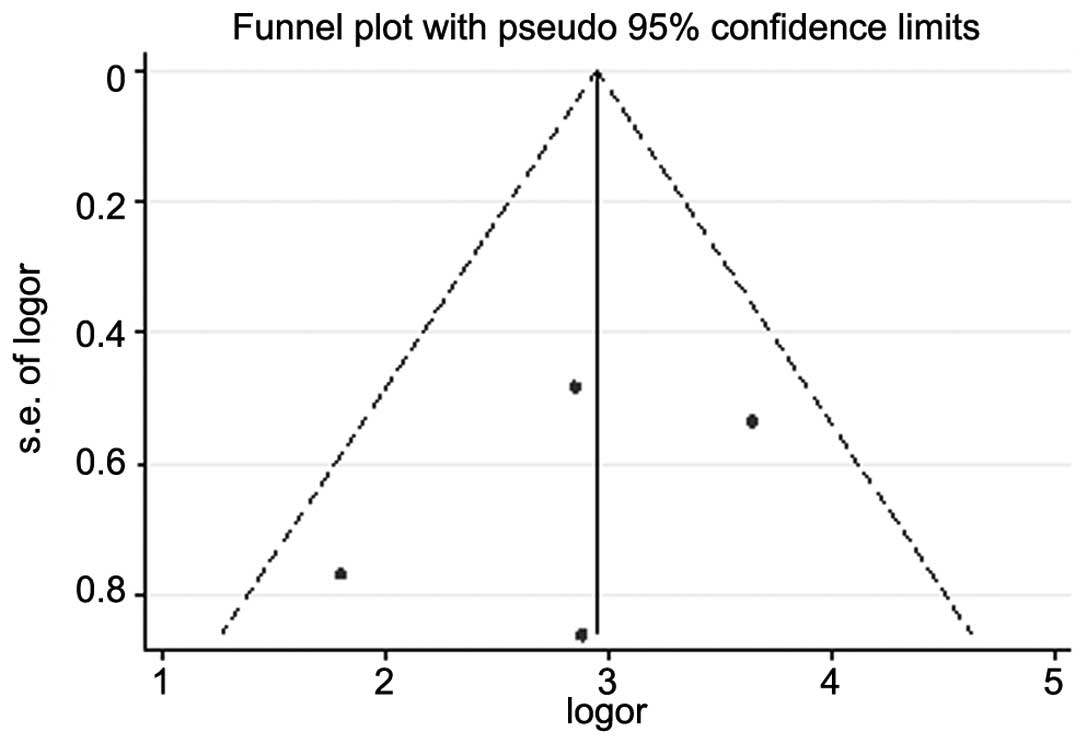Neutrophil gelatinase‑associated lipocalin protein as a biomarker in the diagnosis of breast cancer: A meta‑analysis
- Authors:
- Published online on: March 27, 2013 https://doi.org/10.3892/br.2013.89
- Pages: 479-483
Abstract
Introduction
Breast cancer is a malignancy that affects women worldwide. Despite developments in surgery and chemotherapeutics, early diagnosis and prognosis of breast cancer remain poor. Previous studies have investigated Muc-1 gene-related protein biomarkers CA15.3 and CA27.29 (1,2), Her-2/neu (3) and CEA (4), however, each of these potential biomarkers has limitations with regard to sensitivity, specificity or the scale of applicability. At present, no single protein serves as a biomarker for the screening of breast cancer. The combined application of biomarkers in biochemical detection, such as CEA-TPA-CA15.3 (5), ameliorates the weakness of each biomarker. However, the cost and complicated evaluation process involved in the detection of this type of cancer suggests a combined application is not feasible. Therefore, it is crucial to identify biomarkers with high diagnostic value.
Neutrophil gelatinase-associated lipocalin (NGAL) also known as lipocalin 2 is a 25-kDa glycoprotein, which was originally identified as a covalent complex with matrix metalloproteinase-9 (MMP-9) in human neutrophil (6,7). NGAL has recently been investigated in a variety of physiological and pathological conditions. As a biomarker, the diagnostic value of NGAL has been identified in acute kidney injury (8). Additionally, NGAL is involved in various types of human cancer. NGAL expression is upregulated in the majority of human cancers, including colorectal neoplasia (9–11), gastric cancer (12), oesophageal squamous cell carcinoma (13), lung adenocarcinoma (14), primary liver carcinoma (15) and thyroid neoplasia (16). However, this expression is downregulated in cancers such as pancreatic (17–19) and prostate (20), as well as chronic myeloid leukemia (21,22).
The NGAL gene in human is highly expressed in luminal epithelial cells compared to myoepithelial cells (23). Subsequently, the majority of breast carcinomas were thought to develop from luminal epithelial cells. Thus, NGAL may actively participate in breast cancer progression (24). NGAL levels were also strongly correlated with poor histological grading, lymph node metastasis, high carcinoma proliferation ability and weak prognosis of breast cancer patients (25).
However, no specific study has sufficiently evaluated the correlation between NGAL expression and the risk of breast cancer. Therefore, in the present study, we aimed to estimate the possibility of NGAL as a biomarker in the early diagnosis of breast cancer via a meta-analysis of published literatures.
Materials and methods
Data sources and search strategy
The meta-analysis of Observational Studies in Epidemiology (MOOSE) guidelines for the conduct of meta-analyses of observational cohort studies were followed. Two invesgators (Y.W. and T.T.Z.) conducted a literature search using PubMed, OVID, ScienceDirect and the China National Knowledge Infrastructure (CNKI) databases, including all published papers until November 2012 using a combination of the following terms: neutrophil gelatinase-associated lipocalin, NGAL, Lipocalin 2 and breast cancer. There were no language restrictions.
Publication selection
The investigators Y.W. and T.T.Z. independently reviewed potentially associated publications by checking their titles and abstracts and then procured the most relevant papers for further examination. Moreover, the reference lists of the selected studies were also screened for any potential information. The criteria used to select studies for the meta-analysis were: i) studies focusing on the association of NGAL with breast cancer; ii) observational studies; iii) studies that reported breast cancer pathological diagnoses and sources of cases and controls; iv) test methods [immunohistochemistry (IHC) or ELISA] and v) completeness of data, or availability of information that proved useful in deriving results. Exclusion criteria included: i) different design and definition of experiments; ii) source of cases and controls and other important information could not be obtained; iii) animals or in vitro experiments; iv) reviews and repeated literature.
Data extraction and study quality assessment
Data including author, publication year, region, study population and the measurement method of NGAL were extracted by two independent reviewers (Y.W. and T.T.Z.) and entered into a database. For conflicting evaluations, agreement was achieved following a discussion. The quality of each included study was assessed using the diagnostic accuracy tool, quality assessment for studies of diagnostic accuracy (QUADAS; maximum score, 14).
Statistical analysis
The studies were analysed using a Chi-square-based Q statistic test to assess heterogeneity and I2 to estimate the degree of heterogeneity. Statistically significant heterogeneity was considered when P<0.05 and the I2 value was >50%. If there was significant heterogeneity, the random-effect model (DerSimonian and Laird) was used. Otherwise, the fixed-effect model (Mantel-Haenszel) was employed.
The bivariate model was applied for the diagnostic meta-analysis in order to perform the pooled sensitivity, specificity, as well as the positive likelihood (PLR), negative likelihood (NLR) and diagnostic odds (DOR) ratios. Pooled estimates with the corresponding 95% CI were initially calculated using the appropriate statistical analysis model. In addition, summary receiver operator characteristic (sROC) curves were constructed. The area under the curve (AUC) value with the Q-value was also calculated to present an overall summary of test performance in order to differentiate between a diseased and non-diseased participant. Spearman’s correlation coefficient of sensitivity and 1-specificity was calculated to estimate the threshold effect. The publication bias of included studies was assessed using the effective sample-size funnel plot and Egger’s test.
Statistical analysis was implemented by MetaDisc 1.4 and Stata 11.0 software.
Results
Search results and study characteristics
The systematic literature search generated a total of 183 references based on the search strategy. We excluded 170 studies after screening the titles and abstracts, as the majority of these studies did not fulfill the criteria for our meta-analysis, while others were excluded due to duplication or review articles. A careful review of the remaining 13 studies revealed that 4 studies did not focus on the association between NGAL and breast cancer, and were excluded. Subsequently, a further 5 studies were excluded; 3 studies were excluded as they were performed on tissue microarrays and lacked control groups (25–27) and 2 studies were excluded as they did not interpret the IHC results with regard to negative/positive and had insufficient data for constructing the 2×2 contingency tables (24,28). Following exclusion of the abovementioned studies, 4 studies were included in this meta-analysis (29–32). A flow chart showing the study selection procedure is given in Fig. 1.
A database was established based on the extracted information from these 4 studies (Table I). These 4 studies were single-center trials conducted in China and included 332 breast cancer patients. NGAL expression was analyzed in paraffin sections by IHC. The quality of each study was appraised according to QUADAS. The results are shown in Table I.
Diagnostic accuracy analyses
The forest plot of sensitivity, specificity, PLR, NLR and DOR for NGAL test in breast cancer diagnosing is shown in Figs. 2 and 3. The overall pooled sensitivity and specificity of all studies were 64% (95% CI, 0.59–0.69) and 87% (95% CI, 0.81–0.92), respectively. The overall pooled PLR and NLR were 5.63 (95% CI, 3.63–8.74) and 0.32 (95% CI, 0.14–0.71). The pooled DOR was 18.02 (95% CI, 9.84–32.98).
Summary receiver operating characteristics
The sROC curve for NGAL expression showing true-positive rates against false-positive rates from each study demonstrates the trade-off between sensitivity and specificity. The studies were included to construct the sROC curve (Fig. 4). The AUC for the diagnosis of breast cancer was 0.9008 and the Q*-value was 0.8321.
Test of heterogeneity
A threshold analysis was performed to explore the threshold effect, which was evaluated with the Spearman’s correlation coefficient, using the Moses model weighted by inverse variance. Not statistically significant difference was observed (Spearman’s correlation coefficient, 0.8, P=0.2).
Cochran’s Q test and the I2 statistic were used to evaluate the presence of statistical heterogeneity in the 4 studies examined (Figs. 2 and 3), and the following results were identified: pooled sensitivty (Chi-square=51.95, I2=94.2%, P<0.001), specificity (Chi-square=2.62, I2=0, P>0.05), PLR (Chi-square=2.36, I2=0, P>0.05), NLR (Chi-square=48.94, I2=93.9%, P=0.001) and DOR (Chi-square=4.01, I2=25.3, P>0.05). By meta-regression analysis, the number of cases in control group or QUADAS score was not the heterogeneity source.
Publication bias
Funnel plot and Egger’s test were performed to access the publication bias of these studies. The shape of funnel plots showed symmetry (Fig. 5). The P-value of Egger’s test was 0.5. The result did not suggest any evidence of publication bias.
Discussion
NGAL is a small, secreted glycoprotein with proposed functions in cell proliferation, survival and morphogenesis. NGAL is expressed in a variety of tumor types including breast cancer (25). In normal human mammary epithelial cells, NGAL expression is under estrogen control (33), while in malignant human mammary epithelial cells, NGAL appears to escape from hormonal regulation, since this protein is most abundant in ER-negative breast cancer cell lines and primary tumor samples (25).
In this study, we clarified the diagnostic accuracy of NGAL for breast cancer by meta-analysis of 4 studies and the results suggested a relationship between NGAL and breast cancer. Using the bivariate model for diagnostic meta-analysis, we found a summary AUC of 0.9008. The DOR is a single indicator used to evaluate the diagnostic value of proposed tests. The pooled DOR of NGAL was 18.02, representative of the odds ratio between breast cancer patients and controls. The pooled sensitivity and specificity were 64 and 87%, respectively, indicating that the assay may result in 36% false-negative and 13% false-positive test results. The overall results indicated that NGAL test may be useful in the diagnosis of breast cancer. However, the low sensitivity but high specificity suggested that a patient with a positive result needed to undergo further laboratory evaluation and imaging.
When PLR>10 or NLR<0.1, the possibility of approving or negating a diagnosis of a disease is significantly increased. In our study, the pooled PLR was 5.63, indicating that the NGAL test was 5.63 times more likely to achieve a correct NGAL-positive test result in the breast cancer group compared with the controls. The pooled NLR was 0.32, indicating that the possibility of the NGAL test achieving an incorrect NGAL-negative test result in the breast cancer group was 32% compared with the controls. The overall results indicated that the NGAL protein test had a certain value in the diagnosis of breast cancer.
The heterogeneity of the 4 studies was analyzed. Results of the Spearman’s correlation coefficient indicated that heterogeneity was not correlated with the threshold effect. The factors, number of controls and QUADAS score were added to the meta-regression, but these did not explain the heterogeneity. We hypothesized that the heterogeneity was due to the limited sample size of the 4 selected studies in this meta-analysis.
Limitations of the present meta-analysis should also be considered. First, the number of studies meeting the inclusion criteria was limited as the focus was on China alone. Studies from other countries were excluded due to the absence of control groups (25–27) or a lack of particular data. Second, IHC was utilized for the detection of NGAL in the 4 included primary studies. One study pertaining to NGAL quantified by ELISA assay of blood sample was not included as the information was not interpreted using odds ratios (28). Third, certain studies used a limited sample size. Thus, due to the limitations of this present meta-analysis, more worldwide studies are required to confirm the value of the NGAL test for breast cancer diagnosis in the future.
In summary, the association of NGAL and breast cancer was assessed by pooling the included data via a systematic meta-analysis. The results of the present study demonstrated that NGAL is a potential biomarker for the diagnosis of breast cancer.
References
|
Gion M, Mione R, Leon AE and Dittadi R: Comparison of the diagnostic accuracy of CA27.29 and CA15.3 in primary breast cancer. Clin Chem. 45:630–637. 1999. | |
|
Gion M, Mione R, Leon AE, Luftner D, Molina R, Possinger K and Robertson JF: CA27.29: a valuable marker for breast cancer management. A confirmatory multicentric study on 603 cases. Eur J Cancer. 37:355–363. 2001. View Article : Google Scholar : PubMed/NCBI | |
|
Luftner D, Luke C and Possinger K: Serum HER-2/neu in the management of breast cancer patients. Clin Biochem. 36:233–240. 2003. View Article : Google Scholar : PubMed/NCBI | |
|
Wang Y, Fang F, Shi C, et al: Evaluation of a method for the simultaneous detection of multiple tumor markers using a multiplex suspension bead array. Clin Biochem. 45:1394–1398. 2012. View Article : Google Scholar : PubMed/NCBI | |
|
Nicolini A, Carpi A, Ferrari P and Rossi G: Immunotherapy prolongs the serum CEA-TPA-CA15.3 lead time at the metastatic progression in endocrine-dependent breast cancer patients: a retrospective longitudinal study. Cancer Lett. 263:122–129. 2008. View Article : Google Scholar | |
|
Flower DR: The lipocalin protein family: structure and function. Biochem J. 318(Pt 1): 1–14. 1996. | |
|
Triebel S, Blaser J, Reinke H and Tschesche H: A 25 kDa alpha 2-microglobulin-related protein is a component of the 125 kDa form of human gelatinase. FEBS Lett. 314:386–388. 1992. View Article : Google Scholar : PubMed/NCBI | |
|
Haase M, Bellomo R, Devarajan P, Schlattmann P and Haase-Fielitz A: Accuracy of neutrophil gelatinase-associated lipocalin (NGAL) in diagnosis and prognosis in acute kidney injury: a systematic review and meta-analysis. Am J Kidney Dis. 54:1012–1024. 2009. View Article : Google Scholar : PubMed/NCBI | |
|
Kjeldsen L, Johnsen AH, Sengelov H and Borregaard N: Isolation and primary structure of NGAL, a novel protein associated with human neutrophil gelatinase. J Biol Chem. 268:10425–10432. 1993.PubMed/NCBI | |
|
Hu L, Hittelman W, Lu T, et al: NGAL decreases E-cadherin- mediated cell-cell adhesion and increases cell motility and invasion through Rac1 in colon carcinoma cells. Lab Invest. 89:531–548. 2009. View Article : Google Scholar : PubMed/NCBI | |
|
Zhang XF, Zhang Y, Zhang XH, et al: Clinical significance of Neutrophil gelatinase-associated lipocalin (NGAL) expression in primary rectal cancer. BMC Cancer. 9:1342009. View Article : Google Scholar : PubMed/NCBI | |
|
Kubben FJ, Sier CF, Hawinkels LJ, et al: Clinical evidence for a protective role of lipocalin-2 against MMP-9 autodegradation and the impact for gastric cancer. Eur J Cancer. 43:1869–1876. 2007. View Article : Google Scholar : PubMed/NCBI | |
|
Zhang H, Xu L, Xiao D, et al: Upregulation of neutrophil gelatinase-associated lipocalin in oesophageal squamous cell carcinoma: significant correlation with cell differentiation and tumour invasion. J Clin Pathol. 60:555–561. 2007. View Article : Google Scholar | |
|
Friedl A, Stoesz SP, Buckley P and Gould MN: Neutrophil gelatinase-associated lipocalin in normal and neoplastic human tissues. Cell type-specific pattern of expression. Histochem J. 31:433–441. 1999. View Article : Google Scholar : PubMed/NCBI | |
|
Li LG, Zhou T and Hou YM: Expression and functional analysis of NGAL gene in human hepatocellular carcinoma. J Fudan Univ (Nat Sci). 51:91–98. 2012. | |
|
Iannetti A, Pacifico F, Acquaviva R, et al: The neutrophil gelatinase-associated lipocalin (NGAL), a NF-kappaB-regulated gene, is a survival factor for thyroid neoplastic cells. Proc Natl Acad Sci USA. 105:14058–14063. 2008. View Article : Google Scholar : PubMed/NCBI | |
|
Furutani M, Arii S, Mizumoto M, Kato M and Imamura M: Identification of a neutrophil gelatinase-associated lipocalin mRNA in human pancreatic cancers using a modified signal sequence trap method. Cancer Lett. 122:209–214. 1998. View Article : Google Scholar | |
|
Laurell H, Bouisson M, Berthelemy P, et al: Identification of biomarkers of human pancreatic adenocarcinomas by expression profiling and validation with gene expression analysis in endoscopic ultrasound-guided fine needle aspiration samples. World J Gastroenterol. 12:3344–3351. 2006. | |
|
Tong Z, Kunnumakkara AB, Wang H, et al: Neutrophil gelatinase-associated lipocalin: a novel suppressor of invasion and angiogenesis in pancreatic cancer. Cancer Res. 68:6100–6108. 2008. View Article : Google Scholar : PubMed/NCBI | |
|
Mahadevan NR, Rodvold J, Almanza G, Perez AF, Wheeler MC and Zanetti M: ER stress drives Lipocalin 2 upregulation in prostate cancer cells in an NF-κB-dependent manner. BMC Cancer. 11:2292011.PubMed/NCBI | |
|
Villalva C, Sorel N, Bonnet ML, et al: Neutrophil gelatinase-associated lipocalin expression in chronic myeloid leukemia. Leuk Lymphoma. 49:984–988. 2008. View Article : Google Scholar : PubMed/NCBI | |
|
Leng X, Lin H, Ding T, et al: Lipocalin 2 is required for BCR-ABL-induced tumorigenesis. Oncogene. 27:6110–6119. 2008. View Article : Google Scholar : PubMed/NCBI | |
|
Jones C, Mackay A, Grigoriadis A, et al: Expression profiling of purified normal human luminal and myoepithelial breast cells: identification of novel prognostic markers for breast cancer. Cancer Res. 64:3037–3045. 2004. View Article : Google Scholar | |
|
Yang J, Bielenberg DR, Rodig SJ, et al: Lipocalin 2 promotes breast cancer progression. Proc Natl Acad Sci USA. 106:3913–3918. 2009. View Article : Google Scholar : PubMed/NCBI | |
|
Bauer M, Eickhoff JC, Gould MN, Mundhenke C, Maass N and Friedl A: Neutrophil gelatinase-associated lipocalin (NGAL) is a predictor of poor prognosis in human primary breast cancer. Breast Cancer Res Treat. 108:389–397. 2008. View Article : Google Scholar : PubMed/NCBI | |
|
Wenners AS, Mehta K, Loibl S, et al: Neutrophil gelatinase-associated lipocalin (NGAL) predicts response to neoadjuvant chemotherapy and clinical outcome in primary human breast cancer. PLoS One. 7:e458262012. View Article : Google Scholar | |
|
Stoesz SP, Friedl A, Haag JD, Lindstrom MJ, Clark GM and Gould MN: Heterogeneous expression of the lipocalin NGAL in primary breast cancers. Int J Cancer. 79:565–572. 1998. View Article : Google Scholar : PubMed/NCBI | |
|
Provatopoulou X, Gounaris A, Kalogera E, et al: Circulating levels of matrix metalloproteinase-9 (MMP-9), neutrophil gelatinase-associated lipocalin (NGAL) and their complex MMP-9/NGAL in breast cancer disease. BMC Cancer. 9:3902009. View Article : Google Scholar | |
|
Zhang XF, Zhou SM, Wan L, et al: Relationship between NGAL expression and progression, metastasis and prognosis of breast cancer. J Pract Oncol. 23:206–210. 2008. | |
|
Lv CG and Qi FJ: Expression of NGAL and MMP-9 protein in invasive breast cancer and its clinical application. Guangdong Med J. 32:1287–1289. 2011. | |
|
Wang XH, Guo YY and Gou XM: Expression of NGAL in breast cancer and its clinical application. China Pract Med. 6:43–45. 2011. | |
|
Qiu JM: Clinical significance of determination in tumor cells NGAL levels of breast cancer patients with immuno-histochemistry. J Radioimmunol. 25:546–548. 2012. | |
|
Stuckey R, Aldridge T, Lim FL, et al: Induction of iron homeostasis genes during estrogen-induced uterine growth and differentiation. Mol Cell Endocrinol. 253:22–29. 2006. View Article : Google Scholar |



